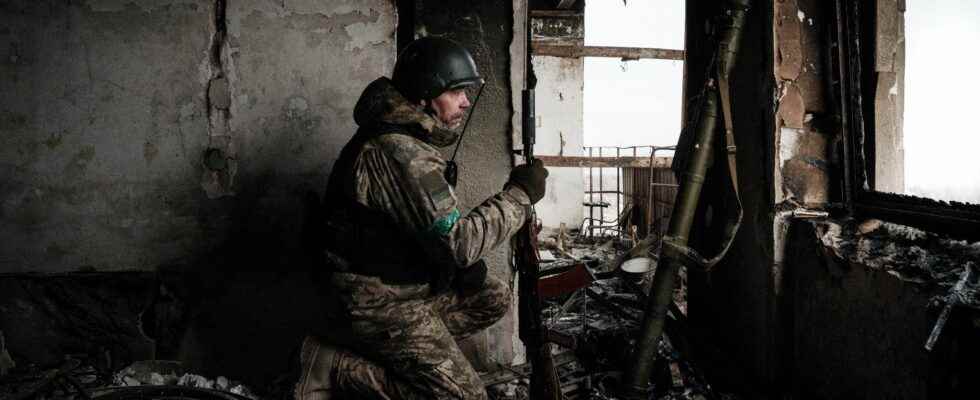A swarm of drones and a deluge of Russian missiles: Ukraine woke up on February 11 after another hellish day of shelling several cities and energy infrastructures. In the previous hours, fighting was intensifying on the eastern front, where Russian forces are looking to make a breakthrough. As we approach the first anniversary of the large-scale invasion orchestrated by Vladimir Putin, everything seems to indicate that the war is entering a new phase.
“The coming weeks will be the hardest for our forces”, admits the governor of Luhansk, withdrawn to the west of his region since the start of the Russian occupation. In an interview at The Express, the senior Ukrainian official describes the intensification of bombardments and attacks in the Kreminna area: “We are probably experiencing the beginning of a major Russian offensive”. According to the Ukrainian Ministry of Defense, the Russian army has mobilized more than 300,000 men, mostly massed on this eastern front, where the Kremlin hopes to fulfill its minimum war objective: to control the entire Donbass. “For Ukraine, there is a serious military risk,” said a French official, while the first tanks promised by Kiev’s western partners will not arrive on the battlefield until spring. Between the two enemy armies, a race against the clock begins to gain the advantage.
Moscow relies on its mass of mobilized
“On the one hand, the Russians are in a hurry because they have mobilized men and want to intervene before Ukraine is reinforced too much, explains General Dominique Trinquand, former head of the French mission to the UN. “, the Ukrainians are well aware that they are very threatened and they want to strengthen their position. But by the time Kiev receives decisive help from its partners, its army will go through – already going through – a difficult patch.”
Moscow is counting on the weight of numbers, by sending successive waves of soldiers to the front – even if it means sacrificing them en masse. It remains to be seen whether this strategy, worthy of the Soviet era, will allow them to break through. On the ground, the performance of the Russian troops still seems to leave something to be desired. A recent incident illustrates this: in Vougledar, a mining town in Donetsk Oblast, at the crossroads of the eastern and southern fronts, the occupying forces suffered a major setback. British intelligence estimates that a recent failed attack in this area led to the flight of Russian soldiers and the “abandonment of at least 30 mostly intact armored vehicles”. Enough to make pro-war bloggers roar: “This episode clearly raises questions of command”, enrages one of the best known, Rybar, followed by more than a million Internet users.
“If the general staff has mobilized tens of thousands of men, the training they receive remains mediocre, underlines Ed Arnold, associate researcher at RUSI, a British think tank specializing in defense and security. In an operation defensively, you can give a soldier a rifle and order him to shoot anything that comes in. To conduct an offensive, on the other hand, an army needs tactical capabilities, so a strong command system to coordinate infantry , armour, artillery and air force.”
Nevertheless, the occupying army has made progress in recent days, slow but real. The Ukrainian presidency admitted on February 13 a “complicated” situation in the village of Paraskoviïvka, about ten kilometers from Bakhmout, which “is facing intense bombardments and assaults” and is today the main target of the Russians. . Opposite, Zelensky’s army has the difficult mission of holding its positions while waiting for tanks, infantry fighting vehicles, air defenses, and additional artillery.
Ukrainians better trained and equipped
On a visit to Paris and Brussels last week, the Ukrainian president also asked his partners for combat aircraft – “wings for freedom” he pleaded. “At the start of the conflict, the Ukrainians resisted an offensive led by the best soldiers of the Russian army – which has now lost most of its elite units, recalls Léo Péria-Peigné, researcher at the French Institute of international relations. And at that time, Ukrainian means of response were less. Today, the troops are using quality equipment thanks to Western aid and have gained enormous experience. They will undoubtedly suffer losses, but he seems to be able to resist.”
The Ukrainian general staff will have to “measure its effort on the defense of certain parts of the ground”, considers General Dominique Trinquand. “kyiv does not hide its desire to carry out its own offensive. To achieve this, the army cannot use all its resources now and must imperatively keep some in reserve.” NATO Secretary General Jens Stoltenberg expressed his concern on February 13: Ukrainian forces are consuming a quantity of ammunition well above the production rate of NATO allies, he warned.
However, their adversary seems to have a considerable reserve of fire. Despite the sanctions, Russia’s cruise missile production capacity has increased, according to a recent note from the European Council on International Relations (ECFR), a Berlin-based research center. “Despite forecasts of ammunition shortages, Russian shelling of Ukrainian positions has continued at relatively constant levels since October,” ECFR said. “Having gone into war economy mode, Russian industry now produces 200-250 new T-72B3 and T-90M tanks per year. The latter has recently appeared on the battlefield in increasing numbers.”
Under these conditions, a Ukrainian counter-offensive seems delicate in the immediate future. In the West, the concern of American and European partners is increasingly palpable. “We must prepare for significant Russian gains in the coming weeks, writes former British army commander Richard Kemp in a recent daily op-ed. Telegram. We have to be realistic about the gravity of things… otherwise the shock risks shattering Western resolve.”
